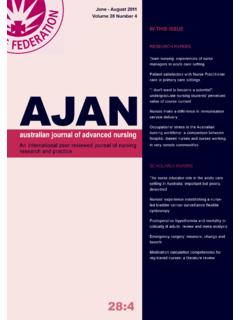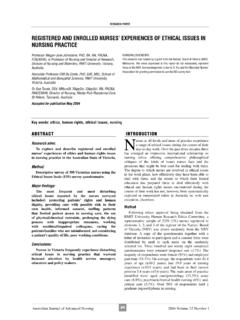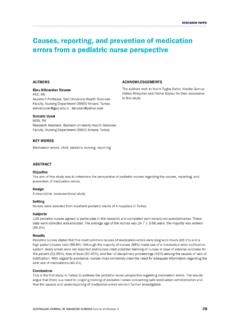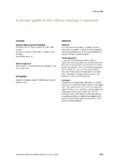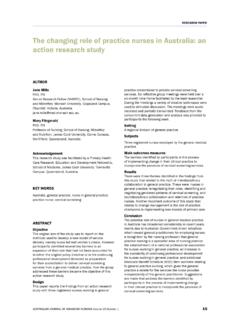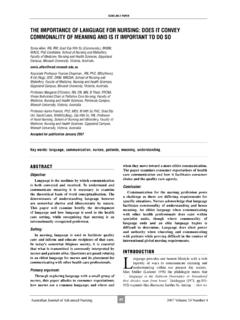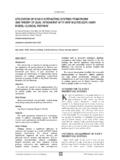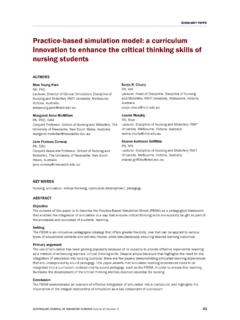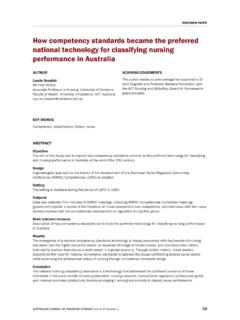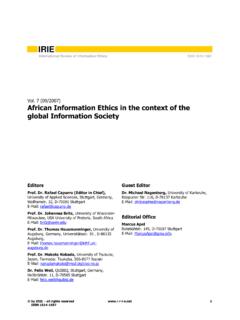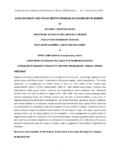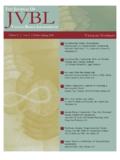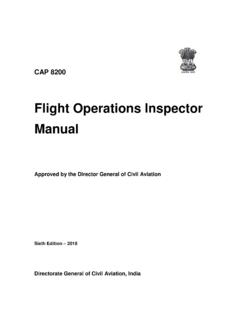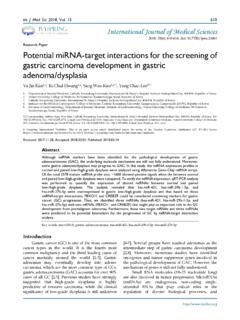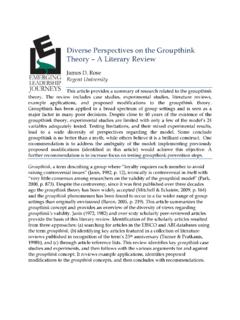Transcription of DYING FOR ATTENTION: PALLIATIVE CARE IN THE …
1 21 Australian Journal of Advanced Nursing 2006 Volume 24 Number 2 ABSTRACTB ackground: PALLIATIVE care has emerged as a specialist disciplinein the past 25 years. However in relation to acutehospitals, a sense exists that patients who are receivingend of life care may not experience support which fullyreflects appropriate PALLIATIVE care : This study aimed to analyse the end of life carereceived by patients in the acute wards of a busyteaching : Retrospective analysis using multiple methodsincluding: case note auditing and interviews of keystaff was used to determine the quality of end of lifesupport provided to an opportunistic sample ofpatients who died in acute care : The research site is a 250 bed teaching hospital inSouth : A medical record audit using an opportunisticsample of 20 recently deceased patients from acutewards was used.
2 For each patient, interviews were alsoconducted with two nurses (n=40) selected on the basisof having a major care Outcome: A range of strategies for enhancing the end of lifecare for patients in acute wards were determined,including support for application of a PALLIATIVE CareAdvanced Disease : The lack of appropriate assessment anddocumentation indicates that major opportunities forenhanced service provision exist both in relation tophysical care and even more significantly in relation topsychosocial and spiritual : The end of life care provided for patients reviewedin this study indicates a far from ideal situation in theacute hospital wards of the research setting. Aneagerness from the nurse participants in the study fortools and further support in their practice was notedand augurs well for future developments within theresearch paper describes a retrospective study of the endof life care provided to 20 patients who died inacute wards.
3 The research site is a 250 bedteaching hospital with a focus on service provision forolder people. The aims of the project were to: analyse the end of life care received by patients in theacute wards of the hospital; identify best care principles and relate these to theactual care provision; recommend learning opportunities and strategies fornurses working in the acute wards of the hospital; and identify whether a need exists for a PALLIATIVE CareAdvanced Disease Pathway (PCADP) and identifyother strategies to enhance nursing PALLIATIVE care in theacute findings around nursing assessment, the nurses perceptions of the care provided, communication andKaren Parish, RGN, Dip App Sci (Nursing), BN, MN, ExecutiveDirector of Nursing and Patient Services, Repatriation GeneralHospital, Daw Park, South Glaetzer, RGN, BN, Grad Cert Health, MN (NursePractitioner)
4 , Nursing Coordinator, Community PALLIATIVE care ,Repatriation General Hospital, Daws Road, Daw Park, Grbich, Dip Early Childhood Development, Dip Education,BA Hons, PhD, Professor, Department of PALLIATIVE care , Schoolof Medicine, Flinders University, South AustraliaLynette Hammond EN, BN, Grad Cert in Health,Complementary care Coordinator, Repatriation GeneralHospital, South Hegarty, RN, BN, ( PALLIATIVE care ), Lecturer,Flinders University, South McHugh, RN, Grad Cert Health, Grad Cert RespiratoryNursing, Clinical Nurse, Community, Repatriation GeneralHospital, South AustraliaAccepted for publication January 2006 DYING FOR attention : PALLIATIVE care IN THE ACUTE SETTINGRESEARCH PAPERKey words: PALLIATIVE care advanced disease pathway, quality of nursing care , terminal care , PALLIATIVE careeducation, end of life careAustralian Journal of Advanced Nursing 2006 Volume 24 Number 2decision making, and the psychosocial and spiritualaspects of care are discussed and recommendations forthe way forward are REVIEWIn South Australia, 41% of deaths occur in publichospitals: 26% in non-designated PALLIATIVE care beds and36% in a hospice or PALLIATIVE care designated bed in apublic hospital (DHS 2001).
5 There have been fewcomprehensive studies undertaken to explore theoutcomes of the range of PALLIATIVE services provided invarious care of DYING patients in the acute generalhospital setting international researchInternational studies in relation to DYING in the acutecare setting have persistently indicated that there areproblems with poor symptom control and inadequatenursing care (Mills, Davies and Macrae 1994).Administrative data confirms that interventions andinvestigations often continue up until death (Earle, Elyseet al 2003). Poor communication, in particular clear andhonest communication between health professionals andthe patient, is still a key issue (Curtis, Weinrich et al2001; Carline, Curtis et al 2003).
6 Many nurses neverdiscuss hospice care with their patients and others avoiddiscussing prognosis (Bradley, Cherlin et al 2001).Australian researchAustralian data has been sparse on this topic. An earlystudy in South Australia (Ashby, Maddocks et al 1991)found poor levels of terminal care in public also indicated that doctors were found to beinaccessible and uncaring (Wakefield and Ashby 1992).In addition, 25% of patients had uncontrolled severe pain,57% of hospitals did not have bereavement care and manyrespondents were dissatisfied with the overall standard ofcare. These findings indicated that public hospitals wereconsidered by the majority of respondents to be providingunsatisfactory terminal recently Pincombe et al (1998) examined thecare of 20 patients who died in two acute generalhospitals in South Australia.
7 Findings indicated that theoverwhelming amount of care offered to DYING patients byhealth professionals was associated with routine andtechnological care , and that the presence or absence offamily and their activities and attitudes significantlyinfluenced the quality of care received by the patient. Itwas found that nurses experience considerable stresswhen patients are DYING in an acute care setting becauseof competing demands on their time and/or their lack ofexperience and/or the absence of positive role education in the PALLIATIVE approach for all staffwas recommended. Pincombe et al (1998) concluded thatthe principles of PALLIATIVE care are yet to be fullyincorporated into the acute care Pincombe et al (1998) findings are furtherreinforced by Middlewood et al (2001), who describedpatterns of medical and nursing practice for patientsdying of oncological and haematological malignancies ina Canberra Hospital.
8 They found that although 88 out of100 patients had do not resuscitate orders, 48 had beendocumented less than two days prior to overall results confirm that the principles ofpalliative care had not been adequately incorporated intothe acute care METHODSS tudy designThe study sought to retrospectively analyse the end oflife care provided to 20 patients who died in acute wards ofthe hospital. Multiple methods were used. A case note audittool was developed utilising the Beth Israel (1999) palliativecare advanced disease pathway framework (PCADP). Thisincluded a review of documentation in relation to the majoraspects of comfort care including nursing assessment ofphysical, psychosocial and spiritual from the medical record audit related towhether a comprehensive nursing assessment occurred,whether the appropriate nursing interventions wereimplemented as a consequence of the assessments, andwhether the nurses documented the outcomes of theirinterventions and undertook appropriate modifications tonursing care data was supplemented by data from interviewswith two nurses identified as having a major careinvolvement with each patient.
9 A staff interview tool wasused which was also developed utilising the Beth Israel(1999) framework for their PCADP. Nurses wereinterviewed within one week of the patient s death toenhance recall of the specific episode of selection of medical records to be retrospectivelyaudited was through opportunistic, random sampling. Themedical records selected were those of the most recentlydeceased patients from an acute medical or surgical wardat the time the nurse research assistant was in a positionto undertake the next audit. Medical records wereexcluded if the patient had died unexpectedly without arecognised terminal phase. In total, 20 medical recordswere audited. Interview selection was undertaken throughcase note audit identifying two nurses who were mostinvolved with the patient s care in the last days of considerationsInstitutional ethics approval was gained.
10 Aninformation sheet identifying the nature and rationale forthe study was provided to all nurses approached forinterview consent. Standard statements identifying thatparticipation was voluntary and that participants couldwithdraw at any stage were included. There were noRESEARCH PAPER22 Australian Journal of Advanced Nursing 2006 Volume 24 Number 2difficulties in gaining consent, with only one nursedeclining to participate out of the 40 nurses approached. Data analysisQuantitative data was entered into an Access databasefor storage and manipulation. Qualitative data wasanalysed on a case by case approach to determine specificthemes within the categories in which data were were independently drawn out by two of theresearchers and individually checked by the investigatingteam.
